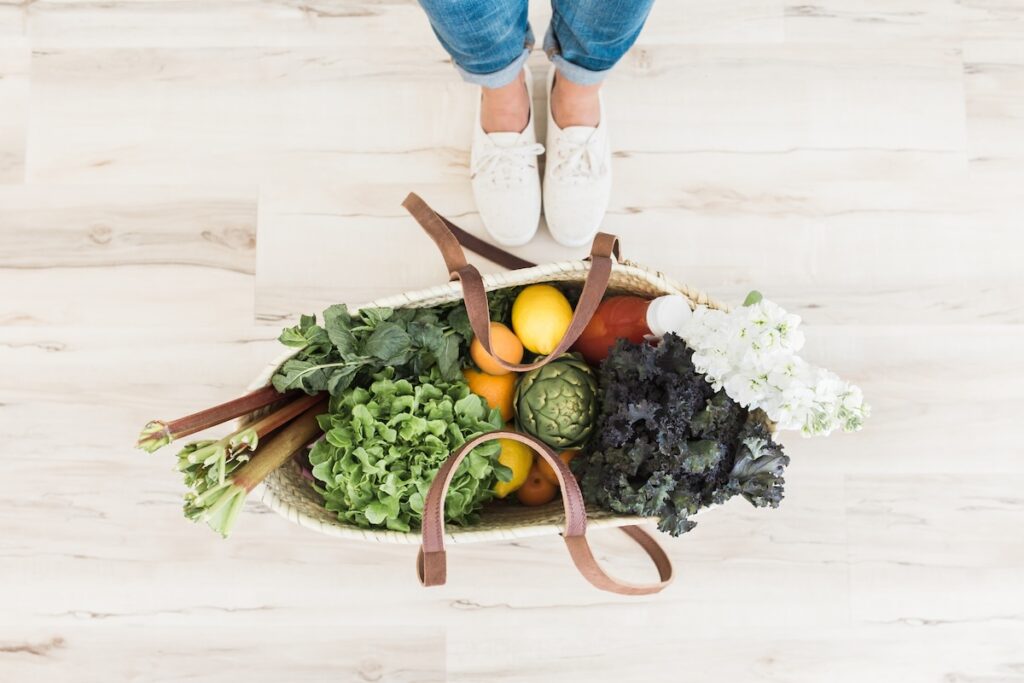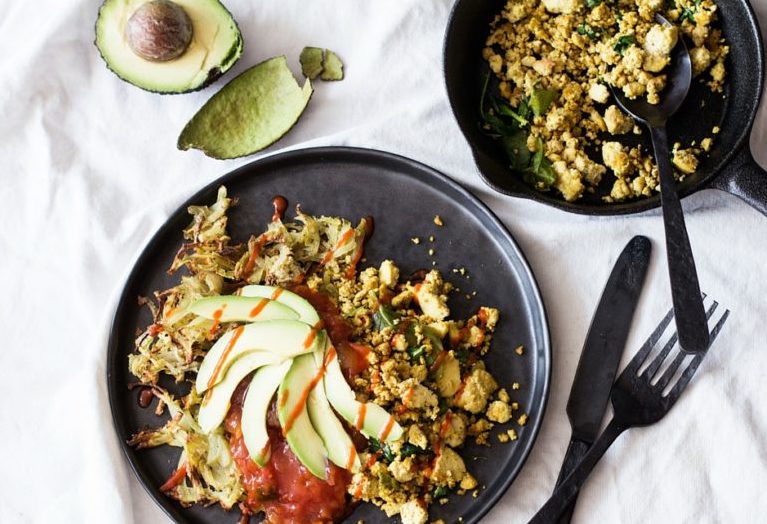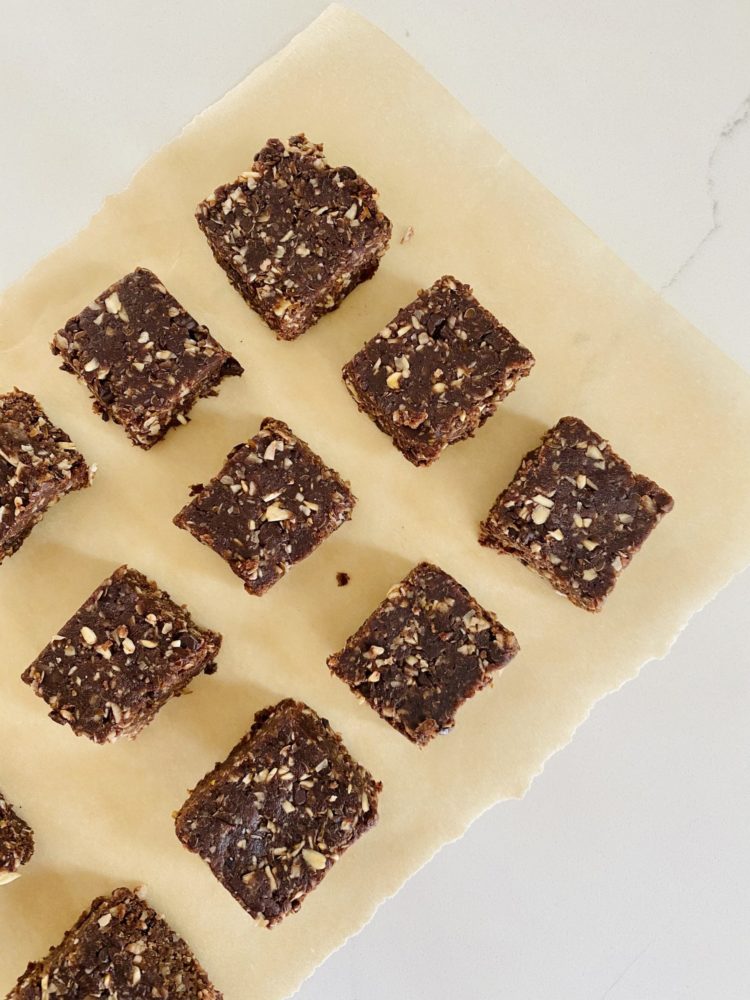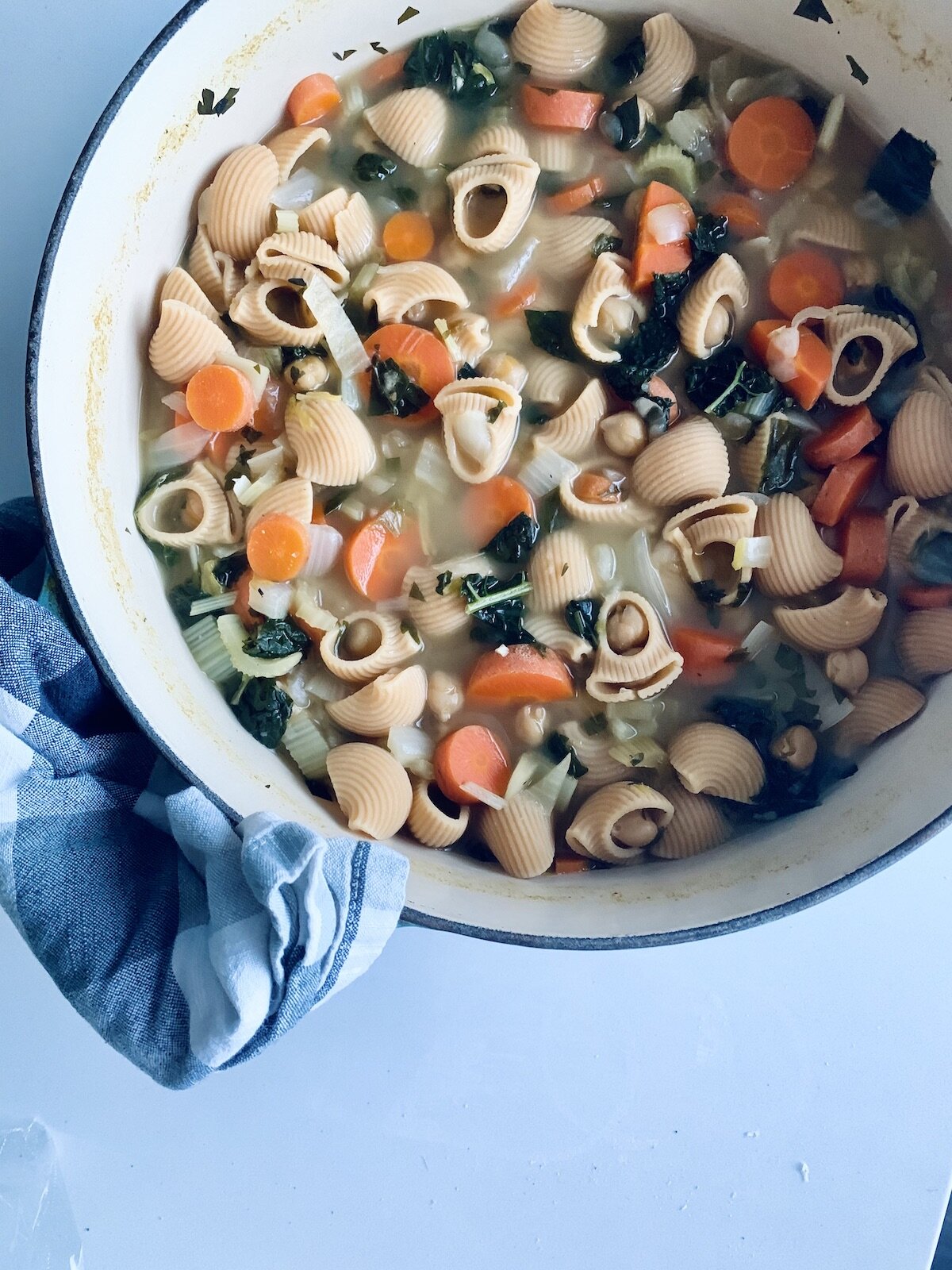Do you cringe at the phrase “meal planning”? A lot of people do, and even more so when they think about plant-based meal planning. It’s synonymous with “time-consuming” and implies that your life includes spacious Sundays filled with pouring over cookbooks, strolling farmer’s markets, and spending hours in the kitchen. If this is not your reality, I understand the resistance to meal planning. It is also a term co-opted by diet culture to help you “stick with the diet plan”. Yuck!
Today, let’s look at meal planning in a new way. After all, the purpose of a meal plan is not to torture you, it’s to support you – to set yourself up for more ease and peace. This list of my best plant-based meal planning tips will be especially helpful if you’re looking to get more plants on your plate and bring more ease into your relationship with food.

Why should you try meal planning?
Meal planning may seem daunting, especially if you’re new to plant-based eating. However, by investing a little time into organizing your meals, you can experience numerous benefits that extend beyond just convenience. From saving money and reducing food waste to enhancing your culinary skills and ensuring balanced nutrition, meal planning can truly transform your eating habits. Here are some compelling reasons why meal planning can lead to plant-based eating that feels easier and more sustainable.
- Keeps You Consistent: Helps stay consistent with incorporating more plant-based foods and regularly eating meals that are nourishing and satisfying.
- Saves Time: Streamlines meal preparation by planning ahead, reducing the time spent deciding what to eat each day.
- Reduces Food Waste: Encourages the use of all ingredients purchased, minimizing spoilage and waste.
- Saves Money: By shopping strategically and planning meals, you can avoid impulse purchases and stick to a budget.
- Promotes Balanced Nutrition: Facilitates the inclusion of a variety of foods, ensuring a balanced intake of nutrients.
- Enhances Cooking Skills: Encourages experimentation with new recipes and ingredients, improving culinary skills over time.
- Increases Convenience: Having meals prepped and ready is a life-saver, especially during busy weeks.
What does a balanced plant-based meal look like?
When you’re planning meals, it can be helpful to have a loose idea of what a balanced plant-based meal looks like. A well-rounded meal not only provides good flavor and texture but also ensures you are getting a variety of nutrients. I like to use the blueprint of a bean (protein-rich foods), a green (fruits and vegetables), a grain (whole grains and grain products), and flavor enhancers (crunchy textures, sauces, garnishes, etc.). Here are the key components you should consider:
- Protein Sources:
Plant-based proteins come from a variety of sources. Consider incorporating legumes (such as lentils, chickpeas, and black beans), tofu, tempeh, edamame, and seitan into your meals. Nuts and seeds are great additions as well, providing both protein and healthy fats. Read more about plant-based protein here.
- Whole Grains:
Whole grains are a satisfying, satiating, and nutritious part of plant-based meals. Examples include quinoa, brown rice, farro, barley, millet, or whole grain pasta. These provide necessary fiber and carbohydrates to fuel your body, along with important vitamins and minerals. They often form the base of plant-based meals.
- Fruits and Vegetables:
Include a colorful array of fruits and vegetables. Anything goes! Aim for a mix of leafy greens (like spinach or kale), cruciferous veggies (like broccoli or cauliflower), citrus fruits, berries, and brightly colored options (like bell peppers, carrots, and sweet potatoes).
- Flavor Enhancers:
This is anything that brings flavor, texture, and personality into your meals. Examples include dried and fresh herbs, sauces and dressings like my favorite Vegan Cheese Sauce or Easy Peanut Sauce, toasted nuts and seeds, flavorful olives or capers, and more!
7 Strategies To Make Plant-based Meal Planning Easier
Here’s the thing about meal planning: there is no such thing as a one-size-fits-all solution! Every person’s lifestyle, schedule, preferences, and resources are different. This means that we all need a unique approach to meal planning. The tips below are ones that you can customize based on your situation and desires.
Start with your real life
The best meal plan is one that meshes nicely with your real life – chaos and all. Start by looking at your calendar for the upcoming week and determining how many meals you want to plan for. Are there particularly hectic days? Or nights when your time is limited? Plan quick meals or leftovers for those. Is there a night or two when you’ll have a little more space? Plan to cook on those nights.
Save your family’s favorite recipes
I love a beautiful cookbook or food blog as much as the next foodie, but I don’t think that browsing new recipes is the best strategy for everyone. It can be fun to inject something brand new into your routine, but it also adds the overhead of sifting through recipes, buying new ingredients, and repeatedly referencing the recipe as you cook. Not to mention the unknown of how it will land with your family! A more sustainable strategy is to keep a running list of recipes you’ve already tried and liked. When you’re ready to plan your meals, skim this list instead of the big, wide world of brand new recipes. You’ll probably find yourself saying, “Oh yeah! We haven’t made that in a long time, but I remember loving it!”
Try grocery delivery or pickup
The pandemic has made grocery delivery and pickup much more accessible and affordable. If you haven’t jumped on the delivery train yet, I highly recommend it. It allows you to do your shopping from the comfort of your couch, in between meetings, or while you wait in the school pickup line. Most services allow you to easily re-purchase staples so you aren’t starting from scratch every time you shop. Check your favorite grocery store’s options or try Instacart, Thrive Market, or Amazon Fresh. That being said, I actually don’t have access to local services where I live! So, I simply make my grocery list ahead of time and always shop the same store so my grocery trips are as streamlined as possible. And I place bulk orders are Thrive Market to fill in the gaps.
Prep ahead
After you’ve planned around your real life and shopped for the week, pencil in time to prep some ingredients in advance. Stay with me – this is much easier than it sounds.
Prep ahead ideas:
- Make a large batch of brown rice in the rice cooker or Instant Pot. (This is hands-off prep.)
- Throw ingredients for a soup in the crockpot, cool, and refrigerate to reheat throughout the week. (Again, hands-off!)
- Roast a big pan of vegetables to throw in bowls, salads, and wraps throughout the week. (Throw them in while you watch your favorite show.)
- Pre-chop vegetables. (No way you’ll have time for this? Keep reading.)
- Make a couple freezer meals so you have instant dinners on hand. (Use my Freezer Meals Guide to make it super easy!)
Take shortcuts
Forget the pressure to be a made-from-scratch kitchen goddess. Smart women take shortcuts! Don’t be afraid to rely on food products that save you time and effort.
My favorite shortcuts for vegan meals:
- Canned beans
- Frozen cooked grains
- Frozen vegetables and fruits
- Jarred sauces and dressings
- Baked tofu
- Pre-cut produce (Let someone else do the chopping!)
- Frozen bean burger patties
- Frozen edamame beans
- Canned or dried soups dressed up with additional veggies, grains, or beans
Find your staples
This is hands-down my most effective tip, so listen up. What are three to five meals that 1) you know how to make by heart, 2) are a hit at the dinner table, and 3) you always have ingredients on hand for? Adding these effortless staples into your weekly rotation (at least two meals each week should be from this category) will help mealtime feel less overwhelming and so much easier.
My staples include Chickpea Noodle Soup, 3-Ingredient Bean Burgers, and Tofu Scramble.
Stay flexible
Even the best laid plans don’t always work out, and that’s okay! Remaining flexible about what you eat when will reduce your stress and anxiety around food. Flexibility is one of the key pillars of a healthy relationship with plant-based eating!

Sample 7-day Plant-based Meal Plan
Here’s a sample 7-day vegan meal plan that includes breakfast, snacks, lunch, and dinner. The purpose of this plan is NOT to prescribe what you should eat everyday, nor is it meant to imply that you should eat a brand new recipe at every meal, every day. It’s simply meant to give you a little inspiration to get started on your plant-based meal planning journey!
7-Day Vegan Meal Plan
Day 1
- Breakfast: Tofu scramble with veggies, avocado, and whole-grain toast
- Snack: Roasted edamame
- Lunch: Pasta salad with chickpeas, cherry tomatoes, diced cucumbers, shaved carrots, walnuts, olive oil, and balsamic vinegar. Plus, a peach and dark chocolate
- Dinner: Pizza crust topped with pizza sauce, vegan cheese, roasted red peppers, spinach, and olives.
- Dessert: Chocolate Mousse
Day 2
- Breakfast: Leftover tofu scramble and toast
- Snack: Trail mix
- Lunch: Vegetable and lentil soup with crackers
- Dinner: Black Bean Enchiladas
Day 3
- Breakfast: Peanut Butter and Jelly Protein Smoothie
- Snack: Whole-grain crackers with hummus
- Lunch: Chickpea Salad Sandwich
- Dinner: Leftover enchiladas
- Dessert: Vegan ice cream
Day 4
- Breakfast: Vegan banana bread with almond butter.
- Snack: Larabar
- Lunch: Leftover Chickpea Salad
- Dinner: Stuffed bell peppers with quinoa, kidney beans, corn, and spices.
- Dessert: Coconut milk yogurt with fresh berries
Day 5
- Breakfast: Chia seed pudding made with almond milk, topped with sliced bananas and almonds.
- Snack: Apple slices with peanut butter.
- Lunch: Quinoa tabbouleh with parsley, tomatoes, cucumber, lemon juice, and olive oil.
- Dinner: Tofu Stir-fry with Easy Peanut Sauce
- Dessert: Dark chocolate
Day 6
- Breakfast: Acai Bowl
- Snack: Popcorn seasoned with nutritional yeast.
- Lunch: Black bean and corn salad with avocado, cilantro, lime, and diced red onion.
- Dinner: Thai red curry
- Dessert: Peanut butter cup
Day 7
- Breakfast: Overnight oats with soymilk, chia seeds, and topped with fresh berries and maple syrup.
- Snack: Coconut yogurt topped with granola
- Lunch: Falafel wrap with tahini sauce, lettuce, tomatoes, and cucumbers in a whole-wheat pita.
- Dinner: Quick Black Bean Soup with avocado and tortilla chips
- Dessert: Cinnamon cereal
Plant-based meal planning can be an enjoyable and rewarding experience that makes mealtime easier and less stressful. With a little planning, you can set yourself up for success and food peace!


